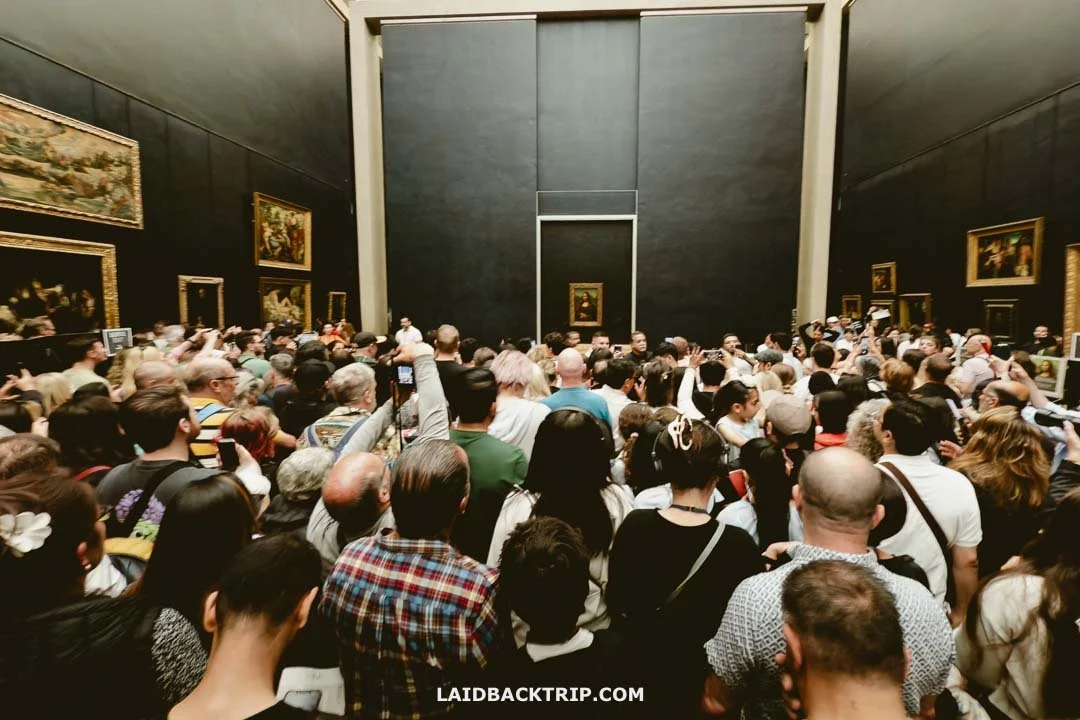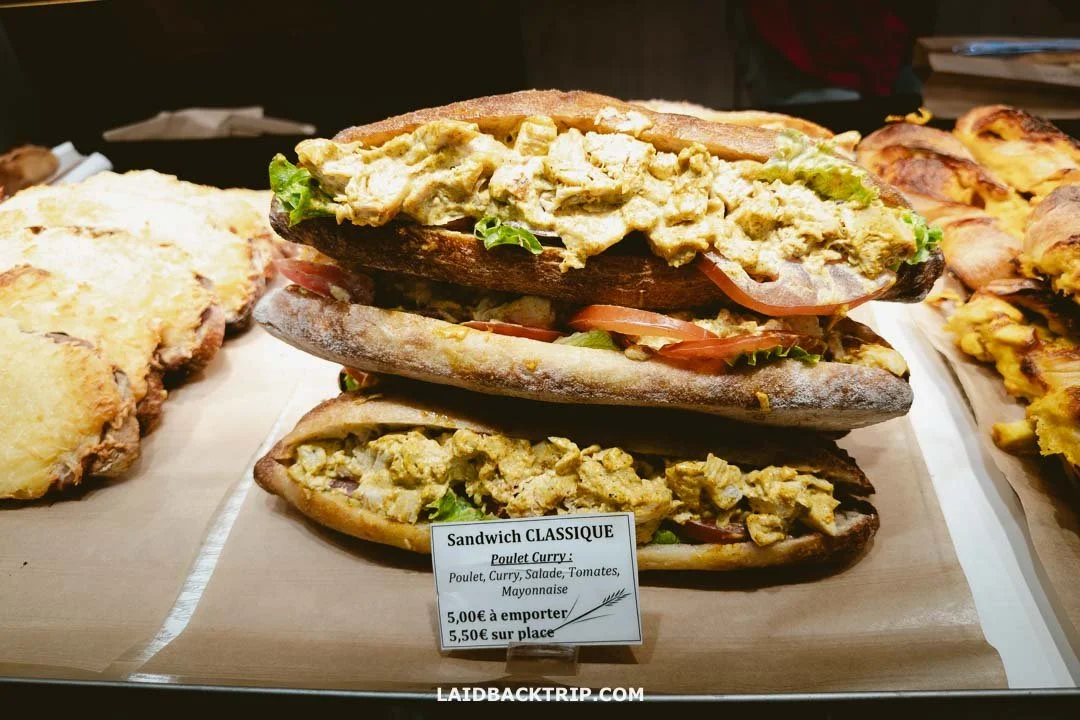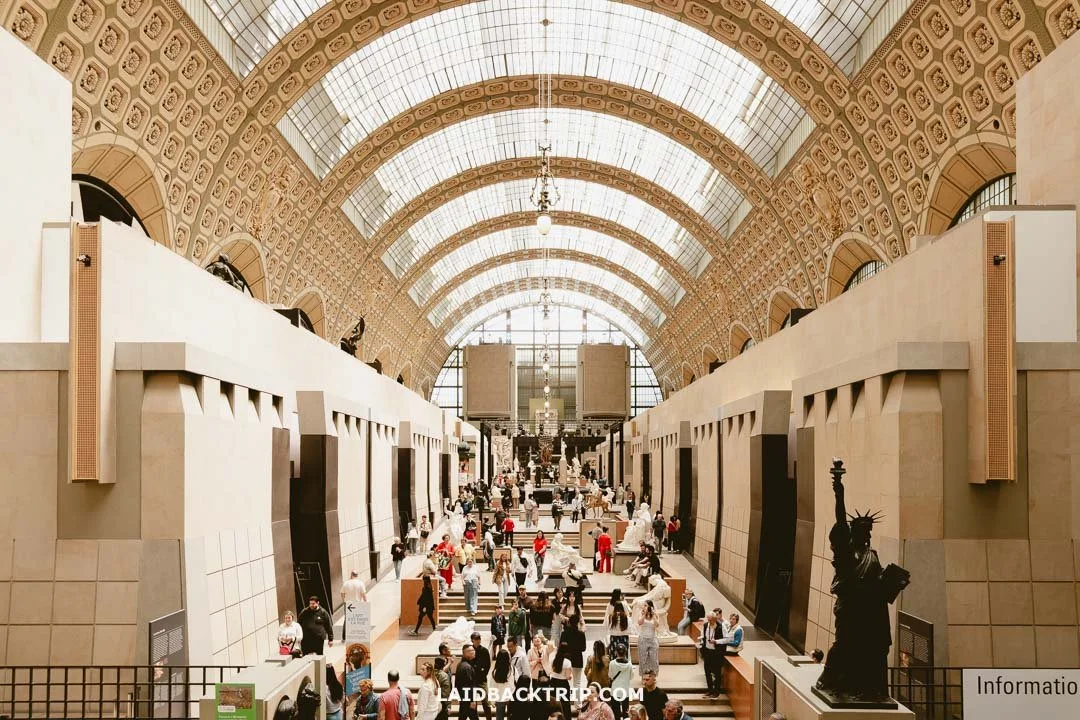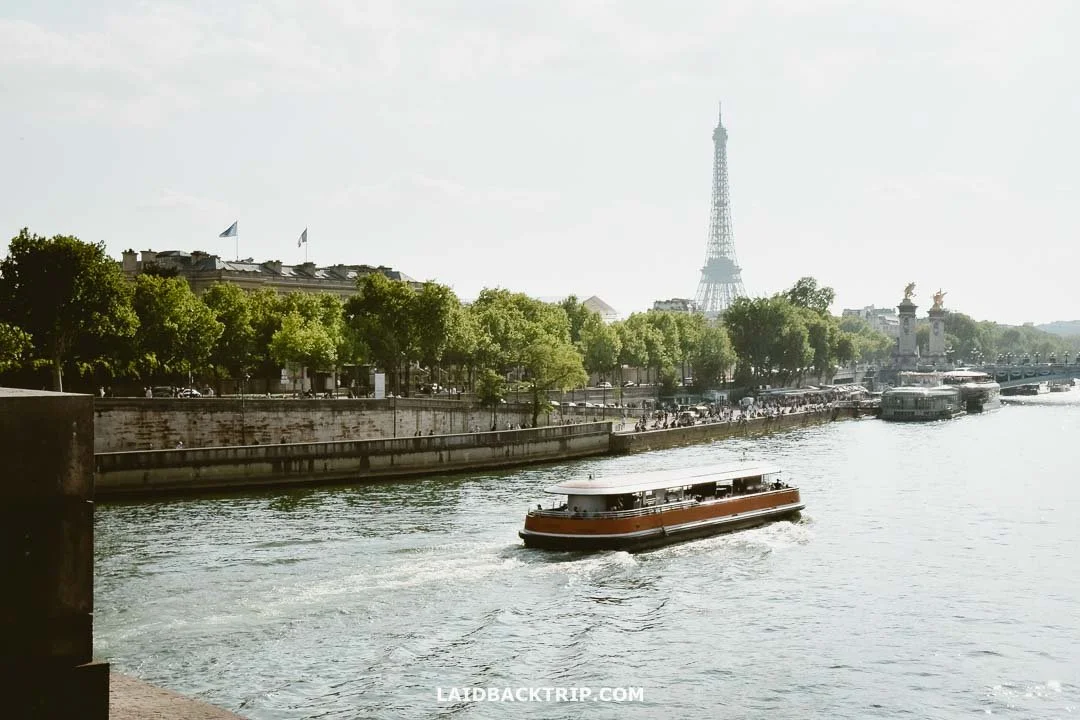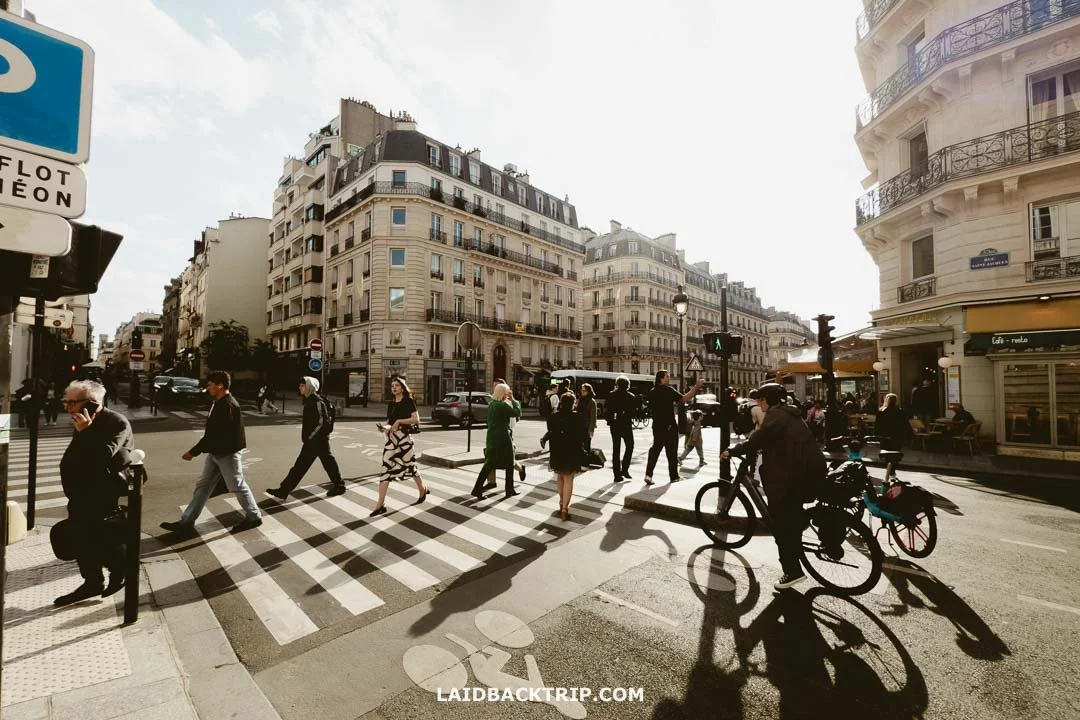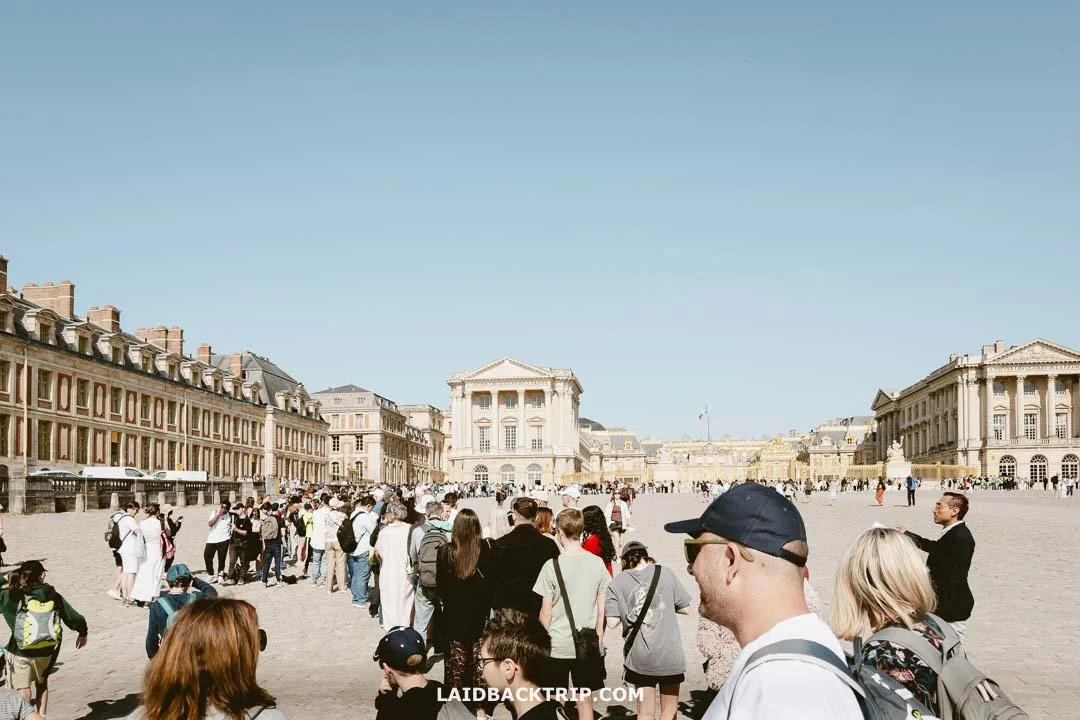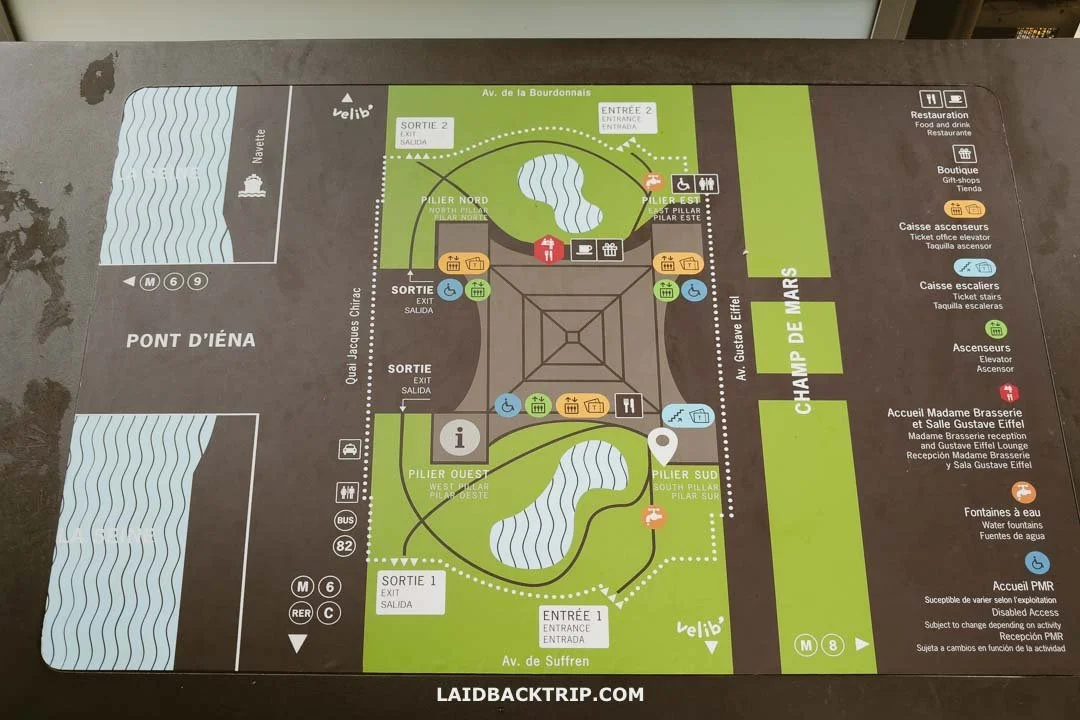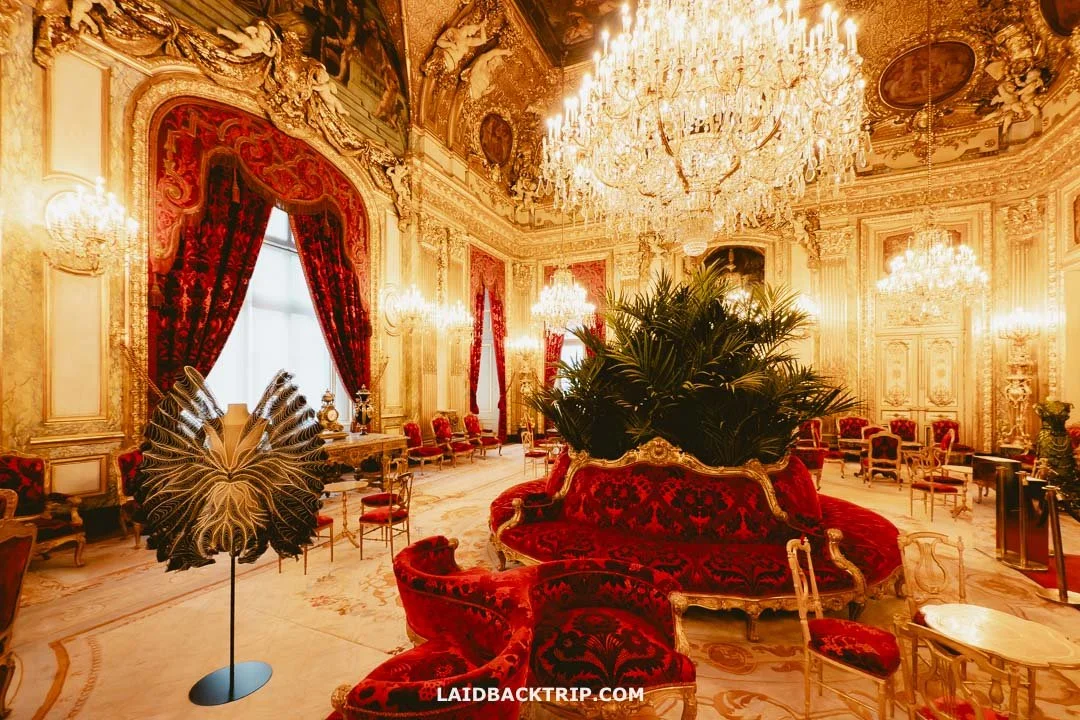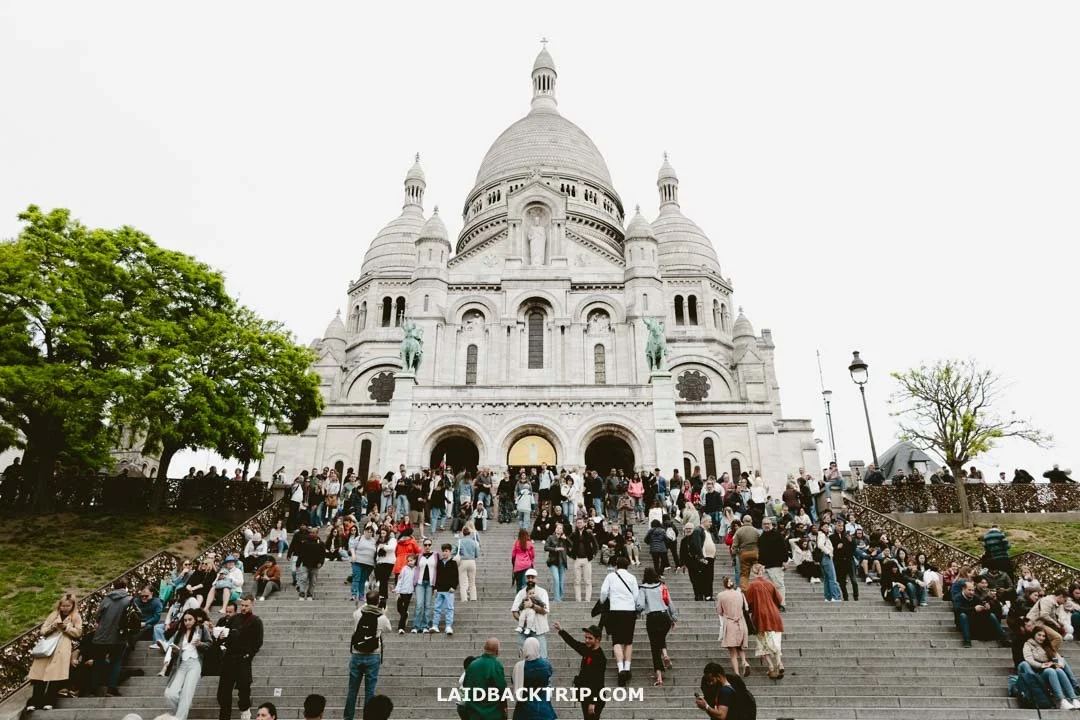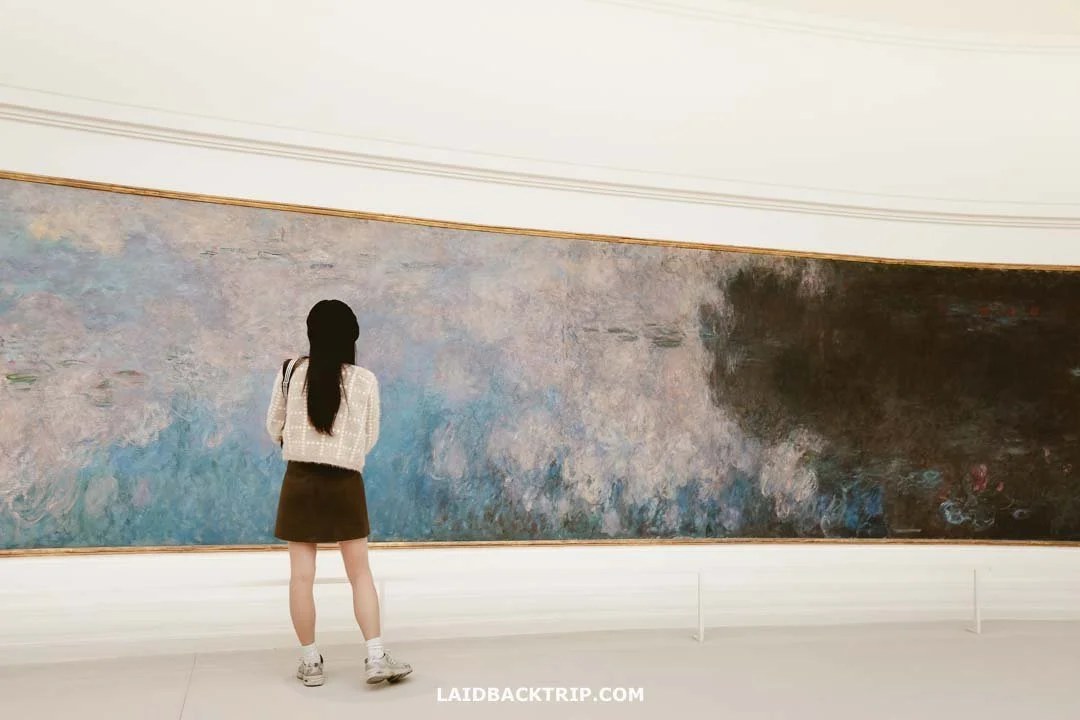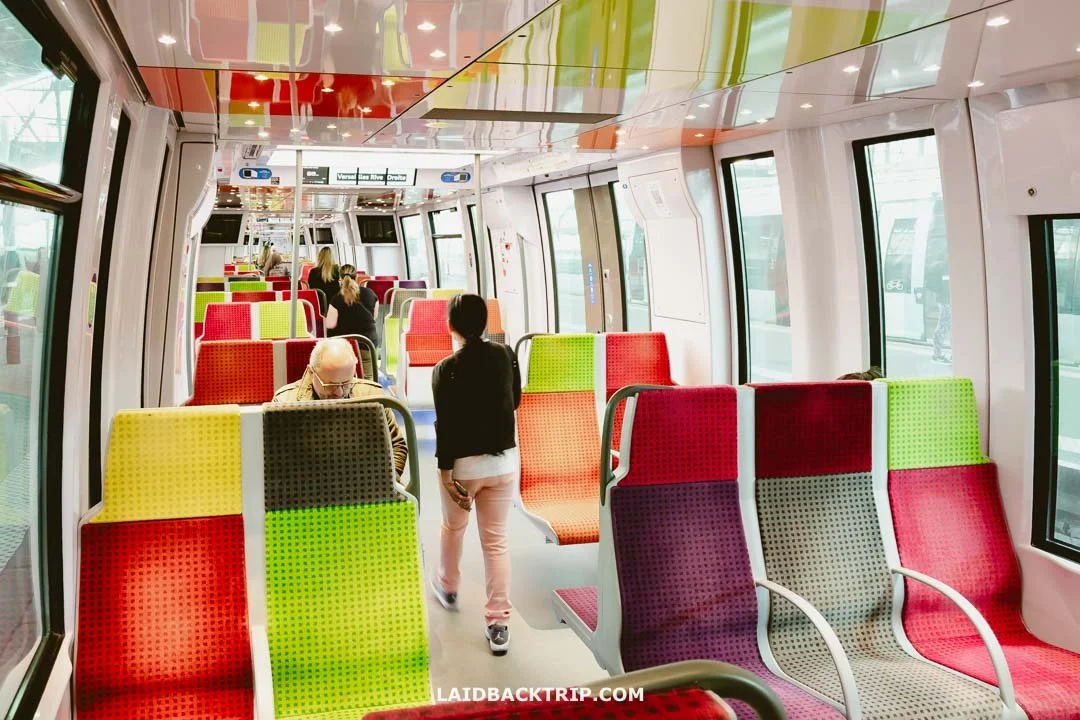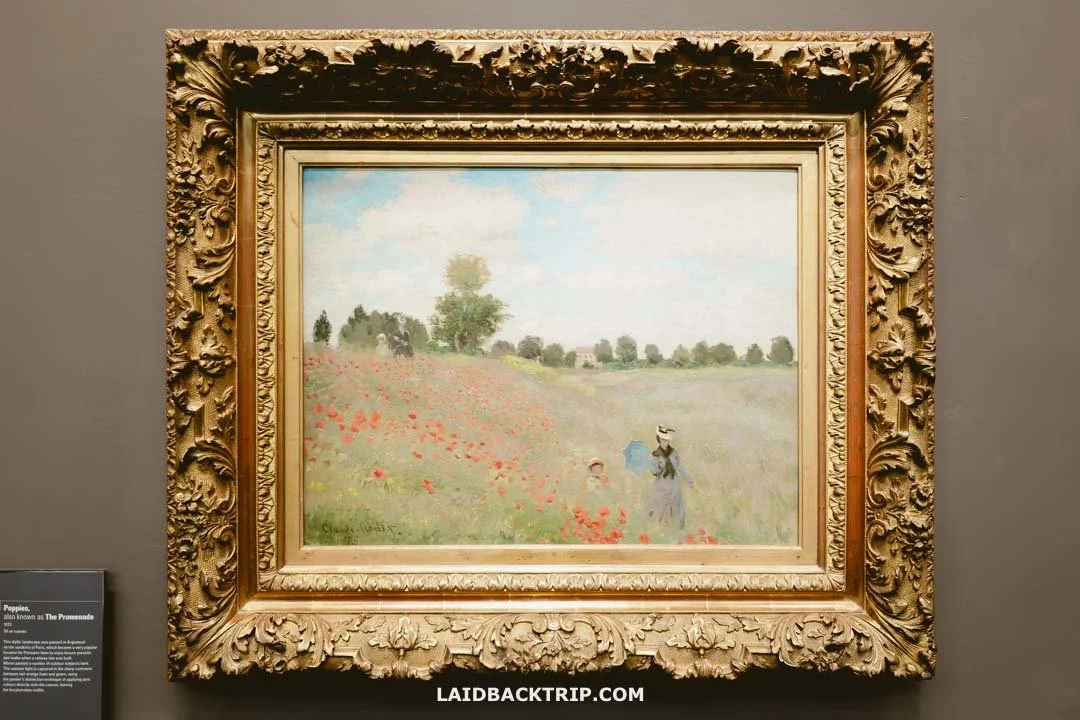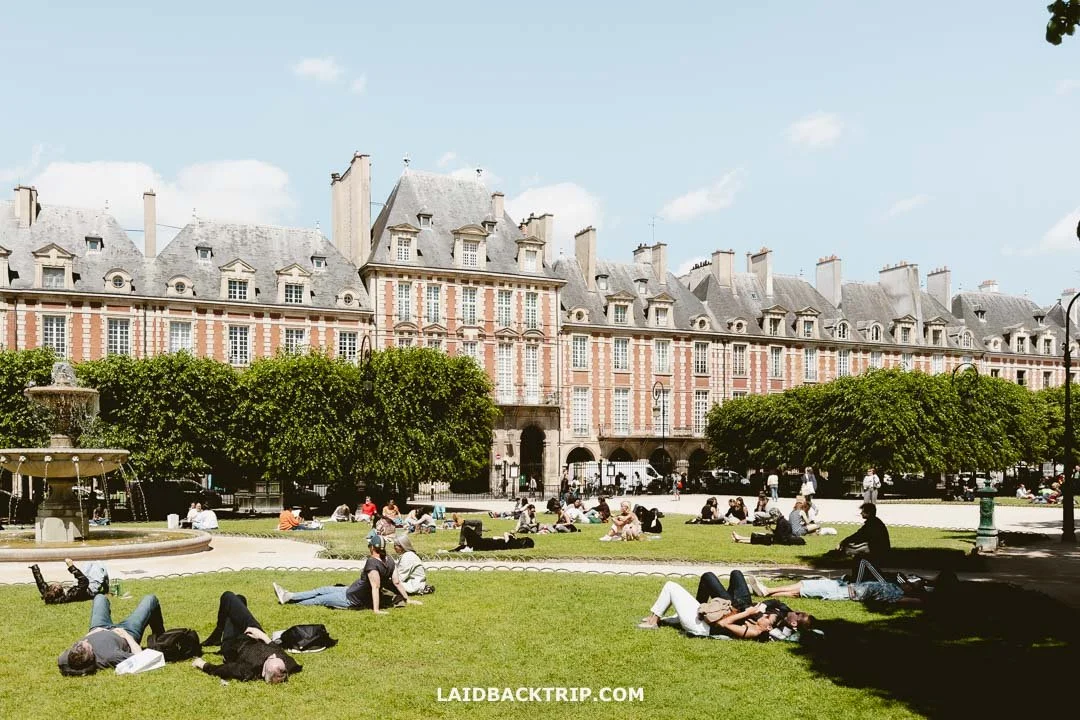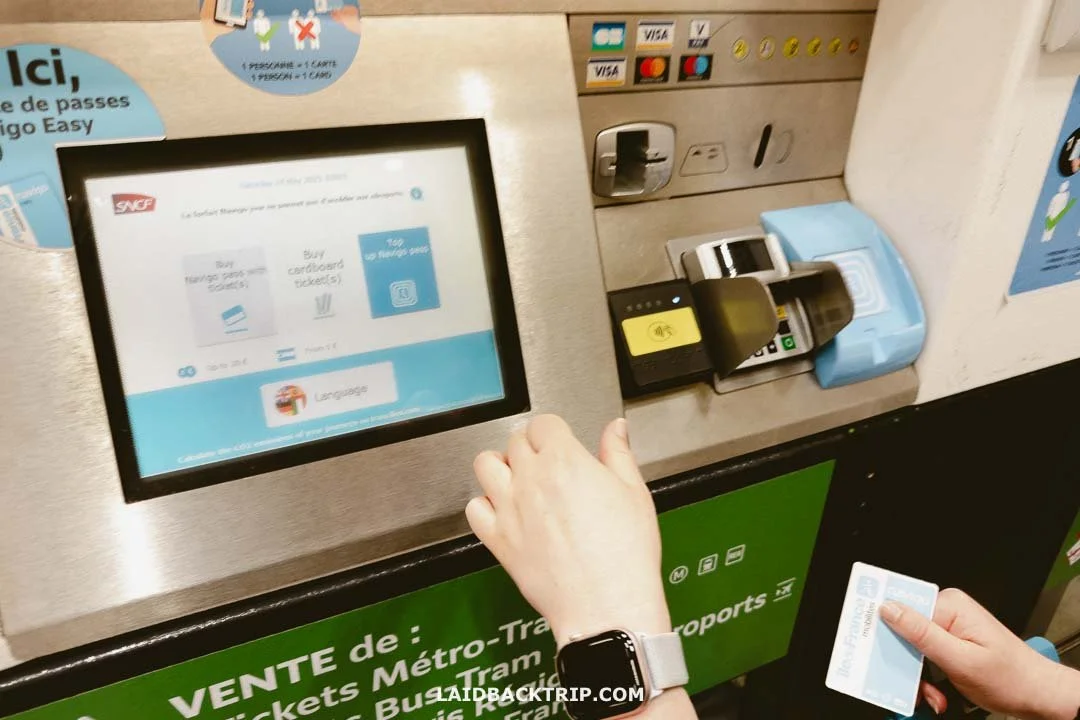45 Things I Learned on My First Trip to Paris (+Tips)
Visiting Paris for the first time is always special, and it was no different for me.
On my first trip to Paris, I kept discovering new things and surprises about the city, so I’m sharing all the tips I picked up during my week there with you right here!
My first visit to Paris definitely wasn't quite how I'd pictured it. I always thought Lucie and I would go for a long weekend, see the Eiffel Tower, visit a French restaurant, maybe check out the Louvre or Versailles if we had time, and then fly back home.
But the circumstances let us stay for a full eight days, giving us way more time for everything - food, attractions, walks, and all that. And since Paris is so incredible, there was a lot to take in.
As you've probably guessed, this was my first chance to explore Paris. In those eight days, I saw things I expected to see in Paris, but I also discovered a ton of new things and quirky little details that totally surprised me. I originally planned to keep it short, but I realized I had taken a ton of notes, and with each tip I added, it slowly turned into this massive first-timer's Paris guide with over 10,000 words!
Since Lucie had already been to Paris, and many of these things wouldn't be new to her, I decided to take notes just on my own. Don't worry. You'll still get a few of her insights, but mostly, this is my take on Paris as a first-time visitor. Some of the notes are practical and useful; others are just random little things I happened to notice.
Merci and Bonjour Are Your Friends
In the touristy parts of Paris, I kind of assumed we'd manage without speaking French, after all, the city gets visitors from all over. And I was right.
Whenever we needed information or help at tourist spots like a museum, airport, or restaurant, (very) basic English was enough. Probably the best situation was at our hotel, where all the receptionists spoke English pretty well, at least when it came to the usual hotel stuff.
The fewer tourists a place had, like regular grocery stores or a boulangerie a bit off the main paths, the more English became a bit of a challenge. Still, we only needed basic things and could figure most of it out on our own, so there weren't any real issues.
In tourist places, we got by with English pretty easily.
I only know a few French words, while Lucie knows some phrases, but that's about it. So we mostly stuck to English since it was usually faster, throwing in a French word or two here.
The two words we used most were obviously merci (thank you) and bonjour (hello). I'd read a lot that these go a long way with Parisians, but honestly, I didn't find they made much difference compared to just starting in English.
It felt like it was more about my attitude and how I asked for things than using "magic" French words to seem polite. The problem with using French was that people would often assume I spoke more than I actually did, and then explaining I didn't, definitely slowed things down. So again, basic English worked just fine in tourist areas.
Crowds Were Everywhere (and They Were Huge)
It's really not that surprising when you think about it. Paris, including the whole metro area, is one of Europe's biggest cities, and the city center is one of the most visited spots on the planet. Still, it took me a couple of days to get used to the constant stream of people wherever we went.
The biggest crowd was clearly for the Mona Lisa.
The relatively nice weather probably played a part, too. It wasn't just the iconic sights that were packed with crowds; even just walking down the main streets meant weaving through people. If you're used to big city life, though, it might not stand out as much as it did to me.
Fresh Baguettes Were So Good
Between the crispy crust, soft inside, and classic shape, the baguette quickly became one of our favorite French food staples. It was cheap, too, which made it a perfect go-to for our breakfasts. Most mornings, we'd grab hummus, tomatoes, and some fruit to go with it, and that combo pretty much became our daily breakfast routine for the whole trip.
Mmm, just perfect...
We tried buying baguettes in the evening to save time, but by the next morning, they'd lost that fresh crunch. Honestly, nothing compared to picking one up straight from the bakery in the morning and eating it while it was still warm, even if it meant a bit more effort to get out a bit earlier.
Different Prices for Here and to Go
Speaking of baguettes, one thing that really surprised me was that France has different prices depending on whether you eat inside or take your food to go. So I quickly learned two useful French words: À emporter (takeaway) and Sur place (eat in). After a quick search, I found that the VAT in this case is supposed to be 10%.
We usually just got takeaway, since it was cheaper.
But it felt like every place made up its own prices. In one boulangerie, we paid €5.50 instead of €5 for a baguette, which kind of made sense. But then they asked €1.80 instead of €1.40 for a croissant. When we visited Pierre Hermé, we thought about enjoying the desserts inside, but when we saw the chocolate cake listed at €16 instead of €10 for takeaway, we chose to enjoy it in a nearby park instead.
Parisian Pastry Is Something Else
It all started during check-in when the receptionist gave us a fluffy piece of a local pastry called les choupettes de chouchou. Maybe it was a long journey, but those cream puffs were incredible. My oh my, it was like stepping into dessert heaven. But that was just the beginning.
In the next few days, we likely ate more pastries than we had all year. Patisseries (and bakeries) were on nearly every street corner. Everything looked gorgeous, smelled delicious, and tasted even better. It was impossible to resist.
Walking into a pâtisserie in Paris was something else entirely.
One of our favorite pastimes was walking past boulangeries and patisseries, just admiring how beautifully the éclairs, mille-feuilles, meringues, croissants, macarons, opera cakes, and dozens of others were arranged in the display windows. And when we got too curious, we'd just step in and grab a piece or two.
Lucie even convinced me to visit the famous Pierre Hermé (we went to the one on the Champs-Élysées), which was amazing (prices less so). But I still preferred those small pastry shops tucked around Montmartre.
It Was Already Hot in Museums in May
Even though the daytime temperatures hovered just below 20°C on average, it felt pretty warm inside some museums, or at least in certain areas. And in the more crowded ones, it was almost uncomfortably hot.
The Mona Lisa section at the Louvre and the entire Impressionist floor at Musée d'Orsay, aka the busiest zones, were definitely the worst for this. I honestly don't want to think about what it's like there in the peak summer. It was already warm enough in May.
I really didn’t enjoy the warm-ish weather inside the museums.
I actually wore shorts on the day we planned to visit the Musée d'Orsay and Musée de l'Orangerie, even though it was a bit cooler and windier outside. I just knew we'd be indoors for hours and wanted to stay comfortable. At least we could bring water in (though drinking and snacking were only allowed in designated areas).
The part that really stuck with me was at Centre Pompidou. You take escalators and stairs in these giant glass tube structures to reach the upper floors. They look super cool from the outside, but inside, on a warm day, it honestly felt like walking through a giant greenhouse.
Electric Cars Make the City Center Cleaner and Quieter
One of the first things I noticed almost immediately after we stepped outside Gare du Nord and headed toward our hotel was how relatively quiet the main roads were despite all the cars around. Whether it was taxis, buses, or regular cars, a lot of them were either electric or, at least, hybrids.
Champs-Élysées was still busy with traffic, but electric cars made walking along it much nicer.
It was so nice to walk through the streets without all the noise and pollution you'd expect with that much traffic. It's still not perfect, but the last time we experienced something similar was in Copenhagen. And it seems like things are only getting better from here.
What hasn't changed, though, is the constant honking. I guess that's going to stick around no matter what powers the cars in Paris.
Getting from CDG Airport by Train Was Easy
When I booked the flight tickets and told Lucie, she mentioned that on her first trip to Paris, she landed at Orly Airport. Since it's the smaller of the two main airports, getting to the city center was super easy. And now that there's a metro connection, it's even more convenient.
But we were flying into CDG, which is north of Paris. In short, Charles de Gaulle is one of the busiest airports in Europe and about twice as far from the center as Orly. And since we didn't want to take an expensive taxi and preferred the cheaper train, I was curious how smooth that would be.
Those huge RER B train signs were hard to miss.
So, after a pretty straightforward train ride to Gare du Nord (closest station to Montmartre), I was pleasantly surprised by how easy it was to get from CDG to central Paris. Navigating the large airport, buying tickets, and finding the platform all went super fast and smoothly.
We took the RER B train to Gare du Nord. It was pricier than the bus, but much quicker. The train was busy in the morning, which made sense with everyone heading to work, but it was clean and fairly comfortable.
Once we were moving, some guy pulled out an accordion and started playing a French tune (unfortunately, right next to my head), then went around asking for money before vanishing into the next car to spread the joy there. The last time I saw something like that was on a bus in Quito a few years ago, so I definitely didn't expect it on a Paris airport train.
Paris's Metro Is Great
Even though we walked most of the time, there were a few instances when we took the metro. For example, after watching the sunset and light show at the Eiffel Tower, instead of walking 50–60 minutes back to our hotel, we just hopped on the metro instead.
The metro map looked kind of intimidating at first, but once I gave it a proper look, it actually wasn't hard at all. Figuring out the map was the most confusing part, but everything else about riding the metro was super straightforward.
The Paris Metro was simply great.
Our hotel was around 400 meters from the closest metro station, which turned out to be super handy. Getting back to the room in about five minutes after a full day of walking around was so comfortable. Obviously, that's one of the main reasons we chose the place. And if you're planning a trip, we'd suggest picking a spot close to a metro, too.
Montmartre Was a Wonderful Area for a Stay
I wasn't completely sure if staying in Montmartre for all seven nights was the right call. Looking at the Paris map, I saw that it's about 3–5 kilometers from iconic spots like the Eiffel Tower and Notre Dame, and I worried we might feel too far from the action or miss out on something.
I'd heard about Montmartre's unique charm, but I still had some doubts about whether it would feel too removed from the main attractions. But I have to say, it really clicked for us. We picked Hotel Litteraire Marcel Ayme, BW Premier Collection as our base, and it was a great choice. The place was super comfortable and had everything we needed.
Only Montmartre offers a view like this one.
Even though Montmartre is touristy, it still felt like we were slightly removed from the biggest crowds. I guess it helped that we had to walk about three kilometers to reach Place de la Concorde, which, for us, felt like the middle point between all the places we wanted to explore.
Despite being a bit outside the ‘city center,’ Montmartre was incredibly lively, partly thanks to the great mid-spring weather and partly because that's just the spirit of this bohemian neighborhood. People flock here day and night. And whenever we didn't feel like walking back, being close to the metro (Blanche station was only 400 meters from our hotel) was a lifesaver.
Hotel Rooms in Paris Are Small
While searching for a place to stay in Paris, I discovered that most hotel rooms within a reasonable price range were really small. Like really small. A lot of them were just 15 to 17 square meters, and some were as tiny as 13m² (which was actually supposed to be the size of our room), and it was far from cheap.
I learned there are several reasons for this: the city center is dense, real estate is among the most expensive in Europe, and many buildings now used as hotels weren't originally designed for that purpose. So the result is that Paris has small rooms.
Our room was clean and comfortable, even though it was pretty small.
I checked with Lucie, and she already knew about it, but since upsizing hotel rooms isn't exactly her superpower (and neither of us wanted to raise our budget just for a few extra square meters), there wasn't much we could do. And since we liked the hotel, we decided to book the tiny room anyway.
We had stayed in similarly small rooms before, but only for a night or two. This time, we were staying for seven nights, so we weren't sure how comfortable or uncomfortable it would be. In the end, we were given an accessible room, which was definitely more spacious (I didn't measure it, but it felt closer to 17–18m²). While it was still a bit cramped, it was definitely bigger than what we booked.
I Absolutely Loved Walking by the Seine River
I really fell in love with walking along the Seine River, and it ended up being my absolute favorite free activity in Paris. We found ourselves by the river almost every day, and each time, whether on the left or right bank, it showed us a different side of the city.
The path next to the water was perfect for relaxed walks or quick rest stops. It felt almost peaceful in the mornings, but the vibe changed by afternoon with more people out and about.
One of my favorite things to do was just stand on one of the many bridges and watch the steady stream of river cruises go by. Of course, pedestrian-only bridges like Pont des Arts or Passerelle Léopold-Sédar-Senghor were the best spots for that.
And I haven't even mentioned the best part. While walking along the Seine, we could pretty much see and visit all the major attractions in Paris. Everything we had on our list - the Eiffel Tower, Grand Palais, Place de la Concorde, Musée d'Orsay, Louvre Museum, Notre-Dame Cathedral, or Sainte-Chapelle - was either along the riverbanks or on Île de la Cité.
A classic view with the Seine and Eiffel Tower in the background.
To me, the stretch between the Eiffel Tower and Notre Dame easily ranks as one of the most stunning city walks in the world. With so much beauty, history, and charm packed into every block, it truly blew me away. And yep, it totally makes sense that the Paris, Banks of the Seine have been UNESCO-listed since 1991.
Whenever Possible, We Booked in Advance
We only decided on Paris as our vacation spot a couple of days before we left, so I can tell you from personal experience: last-minute bookings aren't for the faint-hearted. Every time we checked the remaining available slots, I was dreading what I'd find since all the best ones were already taken, and in some places, only a few were left.
Luckily, we had eight days, so we could improvise and make it work. It wasn't perfect, but we figured it out. Whenever possible, we booked everything through the official channels, like the Monuments Nationaux site. While the interface had its annoying moments (like switching from French to English would randomly send me back to the homepage), we at least didn't have to worry about fake tickets (especially with our Paris Museum Pass) or sketchy reservations.
Waiting in line for Sainte-Chapelle was not much fun.
The only place that was fully booked out was Sainte-Chapelle, so our only option was to try our luck and wait in the ‘visitors without tickets’ line. After standing there for over an hour, we just barely got in right before closing.
Waiting in a line, not knowing how long it would take or if they'd even let us in, wasn't exactly fun. And while Sainte-Chapelle was absolutely incredible and worth it, I'm not sure we'd have tried again had we not gotten in on the first attempt.
Paris in May Was Absolutely Breathtaking
So, our visit to Paris in May wasn't something we had originally planned, but I have to admit that when we were weighing our options, the beautiful month and promising weather forecast were what finally pushed us to go.
After eight days, I have to say that mid-May might just be the best time to visit Paris. The crowds were there, but not nearly as overwhelming as they would be in summer. Everything was already green, so all the parks and gardens, with their fountains and blooming plants, were absolutely stunning. The weather was perfect, not too hot, not too cold.
It was already warm enough, so we enjoyed some awesome sunsets over the city.
But what was probably the coolest part was how alive the city felt. People were everywhere, really soaking in the warmer days. Cyclists filled the streets. Restaurants had their outdoor seating fully set up and packed to the last spot. The charming neighborhoods Paris is known for were buzzing with life. It was just so cool to be part of that.
Lucie had visited Paris once in February, so she had a good point of comparison. She often said the city felt very different in winter. Everything was much calmer, with way fewer people, and those cozy restaurants and bistros (and even entire neighborhoods) felt a lot quieter overall.
The only upside she remembered about visiting in winter was that the crowds were way smaller. There were much shorter lines for museums and other tourist spots. Oh, and accommodation prices were noticeably lower.
There Were Often Too Few Restrooms Available
Pretty much at every attraction we visited, there were long wait times for women's restrooms. I know this is a common issue at busy places, but since Paris sees more visitors than almost anywhere else, it felt much more noticeable here. And because many of the attractions are old and have limited space, there often weren't many toilets available, which was quite frustrating.
With so many people around, the WC situation wasn’t a surprise, though.
Probably the worst situation was at the Louvre, which gets an insane number of visitors, but even spots like the Pantheon or Musée d'Orsay weren't much better. Lucie often had to wait 10 to 15 minutes just to use the restroom. Men's restrooms usually had no wait (unless there was just a single unisex toilet), so I spent that time figuring out our next steps or just relaxing with my eyes closed. So, having gone through this a few times, we took every chance to use a line-free toilet. But, at times, there was simply no avoiding the wait.
The City Center Was Walkable (and Flat)
Despite the fact that Paris is big and there were lots of crowds, we walked pretty much everywhere. Honestly, I was quite surprised at how little we needed to use the metro. I was a bit worried it might be too much, but even though we did more than 30k steps per day, it felt totally fine.
I should mention that we love walking and are pretty used to it. And since we had those eight days, we could focus on certain parts of the city and stay within them the whole day. I'm not saying this is ideal for everyone, but it worked for us.
We walked everywhere - Paris is perfect for that.
Probably the most rewarding part was that we got to see a lot just by walking around Paris. For example, on our way from Sainte Chapelle, we didn't take the most direct route back to our hotel, but I was curious about the Porte Saint-Denis and Porte Saint-Martin I'd seen on the map, so we took a 15-minute detour to check them out.
These monuments aren't as famous or grand as the Arc de Triomphe and definitely not must-sees for first-time visitors, but they were pretty awesome, and I'm glad we skipped the metro. After that, we made another little detour to see the unique Oasis d'Aboukir and strolled through the charming Passage Jouffroy, which we'd have missed otherwise.
The Paris Museum Pass Was Well Worth the Price (for Us)
We weren't sure if the Paris Museum Pass would be worth it since we basically arrived in Paris without a set itinerary. But because we were there for eight days and wanted to see a lot of the places included with the pass, we figured we'd give it a try and see if we'd end up saving money. We went with the 6-day (144-hour) pass since that one clearly offers the best value compared to the 2- or 4-day versions.
This was the line for people who showed up to Versailles without tickets.
It worked really well. I saved it on my phone and just showed it at the entrance for both of us at each attraction. At places like Musée d'Orsay and the Picasso Museum, we even had our own line, which almost felt like a skip-the-line option since it didn't include people buying regular tickets or those without one. That was a nice surprise and a big bonus. At Sainte-Chapelle, the Louvre, Versailles, etc., we still had to book a time slot (which was mandatory), with only slight change that during booking, we just selected the free admission ticket.
With the Paris Museum Pass, there was no waiting time at the Musée d’Orsay.
Since we visited a lot of places, we ended up saving quite a bit. I did a quick calculation on the train to CDG and realized that we visited 12 sites, which would've cost us €200 versus €110 for the pass. If we hadn't bought Versailles tickets separately beforehand (because we were worried about time slot availability), it would've been even more. Still, the savings were solid and honestly better than we expected.
Of course, that's just how it worked out for us. Because we came in fairly unprepared, we had to do a bit of extra planning after buying the pass to make the most of it. You can get the Paris Museum Pass through GetYourGuide if you like this channel and prefer to have everything in one place, or you can buy it through the official site as usual.
Even a Week Is Not Enough for Paris
After some serious thought about how long our Paris trip should be, I booked our hotels and flights to make it an eight-day vacation. The next morning, I asked Lucie if maybe we'd overdone it, like, what if we got bored? But that turned out to be a pretty silly thought.
Now that I've spent more than a week in Paris as a first-time visitor, I can honestly say it was just about the right amount of time to see most of the iconic sights and top attractions. But that's still really only scratching the surface.
Sure, we saw a LOT! At the same time, I have to admit there was still so much we didn't get to, so many areas left unexplored and lesser-known places we wished we'd had time for. I could easily imagine us staying another week (or even two!) to really get a deeper feel for this incredible city and all its amazing museums and sights.
Those eight days in Paris flew by in the blink of an eye.
And as for day trips, yeah, we made it to Versailles, but that was the only one. We had no time for other amazing places like Château de Chantilly or Fontainebleau. Lucie mentioned once or twice that we might try to squeeze in another one, but by the sixth day, even she agreed there just wasn't space in our schedule. Oh well… next time, for sure.
Every time I see two- or three-day itineraries for Paris, I can't help but wonder how many compromises you have to make with such limited time, and how much you end up missing out on. I definitely don't think you need to spend a full week in a remote Colombian village like Jardín to really get a feel for it, but when it comes to Paris, I honestly believe that a week is the bare minimum.
It Was Nice to Slow Down
Another reason we chose Paris as our next destination was because European cities offer the chance to slow down. And that's exactly what we were hoping to find there. After our last few trips, like our journey around Iceland or our road trip through Ireland, which were pretty exhausting, we loved the idea of taking things at a more relaxed pace. And Paris turned out to be perfect for that.
The Tuileries Garden was an ideal spot to pause and soak in the peaceful atmosphere.
We still stayed fairly active, but this time, we made room to slow down. We relaxed in parks while enjoying crepes or coffee, watched boats cruising along the Seine, caught sunsets at the Eiffel Tower and Sacré-Cœur, observed the steady stream of people climbing Montmartre's hill, or just sat in gardens, watched the fountains, read about Parisian history or famous residents, and soaked up the afternoon sun.
Sure, our days were still busy. We'd head out early in the morning and return late in the afternoon or evening. But our mindset was different. I'm not sure how much of it was us and how much of it was just the vibe of Paris, but either way, it was awesome.
Some Attractions Might Be Closed
The best parts of the Centre Pompidou were shut down for renovations and will be for five years. The entire Versailles Coaches Museum was closed without any explanation. And even though Notre Dame had technically reopened months earlier, it was still clearly under construction.
Despite that, I have to admit we were incredibly lucky. We arrived in Paris at pretty much the perfect time, and in the end, we saw almost everything we wanted to. Since we had so much time, we even managed to squeeze into our itinerary the museums that are closed on Mondays and Tuesdays.
Notre Dame has reopened after five years, but the restoration work was still not finished.
We also lucked out with booking time slots for the bigger sites. Sainte Chapelle was the only one that was fully booked, and even then, we just squeezed in when we used the 'no tickets' line (though barely). With the size of the line behind us, I have a feeling the folks near the end didn't get in that day.
This brings me to the point that even in perfect circumstances, you won't see everything on your first visit. There might be strikes, renovations, or a certain piece of art temporarily loaned to another museum. Or, like in our case, you simply might run out of time.
Champ de Mars Offers the Best Eiffel Tower Sunset View
I wanted to see the Eiffel Tower at sunset but wasn't sure where the best view would be. So, on our second day, we visited the Eiffel Tower in the morning, not only to see the landmark up close but also to scout out the area a bit.
A few days later, we came back for the sunset. I figured we didn't need to overcomplicate things, so we just went with the classic option: Champ de Mars, the big park right by the tower where you can sit and enjoy the view for free.
Even though it was a bit cloudy and the sunset wasn't quite as spectacular as we'd hoped, it was still a great experience. And the location of Champ-de-Mars was a huge factor in all of this. What I really liked was that we could choose how close or far we wanted to sit since the park stretches quite a bit. And honestly, it wasn't as crowded as I expected.
The Eiffel Tower was just stunning from the Champ de Mars.
Maybe it was because of the overcast sky or the slightly cooler evening temperatures, but I was actually happy we could finally put our jackets to good use. I'd been lugging mine around all day and was glad to stay warm while waiting for the light show.
There were other options, of course, but I figured Trocadéro is probably better for sunrises, Tour Montparnasse wasn't free and felt a little too far, and the Sunset Seine River Cruises seemed a bit too cramped for what we were going for.
Street Art Was Just About Everywhere
I sort of knew there would be plenty of street art in Paris, but since it was my first visit, I was more focused on the traditional attractions most first-time visitors aim to see. So street art wasn't really on my to-do list, but I figured if it was there, I'd spot it naturally.
And that's exactly what happened. All I had to do was keep my eyes open while wandering through Paris's charming neighborhoods. Since we based ourselves in Montmartre, it really wasn't that hard. Street art was literally at every corner.
Montmartre was full of beautiful street art creations.
Honestly, the sheer quantity was kind of overwhelming. At times, I even felt like less might've been more, but I guess that's part of the vibe. I did spot a few really impressive large murals, though maybe fewer than I expected. What surprised me most was the sheer volume of smaller pieces everywhere.
I absolutely loved the tiny creations, though sometimes I wondered if they even still counted as 'art.' There was little graffiti tucked between windows, paste-ups near drainpipes, stencils passing important messages, urban installations in the squares, chalk drawings on the sidewalks… and techniques I couldn't even name. Everything was super interesting, and I often had to pause and really look around because so much of it was small-scale and easy to miss.
La Défense Is Still Remarkable
I had wanted to see La Défense for a long time. I know it's just a business district with a bunch of high-rise buildings, but we don't have anything like that in Czechia, and I've always found places like this fascinating (the downtown with skyscrapers was one of my favorite spots back when we lived in Calgary, too). The only thing I wasn't sure about was when would be the best time to actually visit it.
La Grande Arche is the modern version of the Arc de Triomphe.
Then, while planning our trip to Versailles from Montmartre, I noticed that the L train route passed through La Défense. So I mentioned to Lucie that it might make sense to stop there on the way back from France's most famous château, if we weren't too tired. As it turned out, we had just enough energy left, so we made the stop.
What can I say? La Grande Arche is still grand. It's one thing to see it in pictures, but standing under it in person is a completely different experience. The moment we stepped out of the train station and saw it towering above us was honestly overwhelming. And, of course, the rest of La Défense was pretty spectacular, too.
Tap Water Was Safe to Drink
We drank pretty much only tap water the entire time we were in Paris and had zero issues with it. Whether we were chilling in our room or out exploring, it was always tap water for us. In museums, train stations, and some public spaces, we refilled our bottles whenever we came across a water fountain.
For instance, the Eiffel Tower had two free water fountains according to this map.
When there wasn't one around, we just used the bathroom taps. It was the same quality, so no problem. But honestly, finding a fountain to refill our bottles was never really difficult.
The best part was that all the water fountains we came across in Paris were completely free. So, apart from grabbing the occasional coffee or orange juice, we didn't spend a single cent on water and ended up using a little less plastic along the way, too.
It Was Museums Galore in Paris
One thing I quickly realized about Paris while we were planning each day the night before is that the city is packed with museums. When I scrolled through the full list on Wikipedia, it felt like I'd never reach the end. Of course, Paris is famous for having some of the best museums in the world, but the number of lesser-known ones definitely surprised me.
While we loved wandering through Paris's charming streets, walking along the Seine, checking out the big landmarks, and watching the sunsets over the city, we actually spent a lot of time inside the museums.
Mona Lisa was definitely the most famous artwork we saw in Paris.
Across eight days, we made it to about ten museums, give or take, depending on the definition. And considering there are about 130 scattered just around the city center, you can imagine how little we managed to see, despite spending more time on museums than most visitors probably do.
Of the few smaller museums I had the chance to visit, I definitely liked the Picasso Museum, as it holds one of the largest collections of his work. The second one I loved was the Crypte Archéologique de l'Île de la Cité, which is basically located under Notre-Dame and tells the history of Paris from the Neolithic age through the Roman-Gallic settlement of Lutetia and beyond.
A Chilly, Rainy Day Was Best Spent Exploring a Museum
We really lucked out with the weather and had what I'd call just about perfect conditions. Mid-May brought us mostly warm and sunny days, which we thoroughly enjoyed since it wasn't too hot or too cold. Just being outside was such a pleasure.
We visited the Napoleon Apartments in the Louvre on a rainy day (along with some other things).
It only rained once during those eight days, and since we checked the weather forecast ahead of time, we played it safe and booked a time slot at the Louvre. The forecast turned out to be accurate, and it rained the whole time we were there. But since we were indoors, surrounded by such incredible collections, we didn't mind one bit.
I already mentioned the crazy number of museums in Paris, so if you happen to visit during a particularly rainy stretch or come in winter when the days are short and chilly, you really don't have to worry. Paris museums are the perfect way to spend a bad weather day.
Outdoor Seating in Restaurants Is Cramped
And when I say cramped, I really mean cramped. Sitting in the outdoor areas often felt like being packed in like sardines, so on the few occasions we ate out, we tried to get seated inside to avoid that. The locals seem pretty used to it, but I still prefer a little personal space around my table and food unless it's a super cheap eatery somewhere in Hoi An.
Still, this setup, which nearly every restaurant follows, added such a unique and vibrant vibe to Paris's neighborhoods. It completely transformed some corners, squares, and even entire streets. It was amazing to see, especially in spots like Le Marais, the Latin Quarter, or Montmartre, just how many restaurants we passed and how alive everything felt.
The seating at some restaurants was something else.
For a quick coffee or a glass of wine (or beer) while watching Parisian life pass by, this was an awesome experience. One thing I really appreciated at most places we visited was that we were usually offered a jug of free water. If not, a simple “Une carafe d'eau, s'il vous plaît” usually did the trick.
Paris Is Not Just Eiffel Tower (or Louvre)
Sure, the Eiffel Tower, the Louvre, and Versailles are all incredible places. And as someone visiting Paris for the first time, it was obvious that those were the places I wanted to see first. But beyond the main highlights, I was absolutely fascinated by how much more Paris has to offer. Naturally, I wanted to see the highlights, but even the walk to the Eiffel Tower was an experience on its own.
Paris was full of surprises, no matter where we went.
We started out in Montmartre, which was slowly coming to life after another busy night. Along the way, we peeked into the Cimetière de Montmartre, spotted a massive mural right before Place de Clichy, made our way past the hustle of the Saint-Lazare station, admired the Église Saint-Augustin, crossed the famous Champs-Élysées, strolled along the calm Seine, and finally crossed Pont de l'Alma before reaching Champ de Mars, where the Eiffel Tower stood tall.
All throughout, we passed from one neighborhood to another, from the 18th through to the 7th arrondissement, soaking in the mix of bustling and peaceful streets and constantly admiring the beautiful Haussmannian buildings. And that was just one simple hour-long walk right through the heart of Paris.
We Had to Plan to Make the Most of Our Days
My initial plan was to be pretty spontaneous, but since we had to reserve time slots for most major sights, that wasn't as doable as I'd hoped. If we had to be at the Eiffel Tower by 9:30 AM, we couldn't exactly pop into a tiny museum that caught our interest along the way. There was sometimes room afterward, depending on what we wanted to do next. Because of that, I usually tried to plan just one timed attraction per day so the rest of the day could stay a bit more open.
That brings me to the other 'problem,' which was that there's just so much to see and do in Paris that having at least a basic plan for the next day was essential.
Notre-Dame was already rebuilt when we were in Paris.
Take churches, for example. There are at least a few dozen stunning ones in central Paris. I mean truly incredible ones. Some of the most breathtaking we've ever seen, like Notre Dame, Sacré-Cœur, or Sainte-Chapelle. Then there are the 'less-known' ones like Saint-Sulpice or La Madeleine, which are still amazing. So, we visited five churches on purpose and even went inside all of them.
Then, we happened to walk past Église Saint-Augustin, totally not on our list, and it looked just as stunning as the more famous ones. But we didn't have the time to go inside. And that kind of thing happened more than once.
You could say, 'Well, churches aren't my thing,' but it was the same story with museums. We wanted to visit the Louvre and Musée d'Orsay, obviously the two most iconic ones. But the real question became: which museums do we visit next, and how much time should we spend in each? We knew there was no way we'd see them all. Honestly, we didn't even manage to visit a tenth of them.
Musée de l’Armée and Centre Pompidou were obvious picks for us. Then Lucie chose the Archeological Crypt for the history, I picked Orangerie for the impressionist paintings, and we both agreed on a few others, like the Picasso Museum.
But there were plenty of moments when we passed by places like the Gallery of Paleontology or the Musée du Quai Branly and thought, 'This looks awesome,' but we just didn't have the time. And that's only two examples that show how many choices we had to make to 'explore' Paris in a sensible way.
So, whatever your interests are, we'd definitely recommend creating at least a basic itinerary. That's what we did, and it helped us make sense of the city and plan our days around the major attractions that required time slots. Then, we built the rest of the day around those anchor points and left some space to improvise.
Paris Is Expensive
Okay, I know this isn't some huge revelation, but I really thought we'd spend a bit less on this trip. Turns out, that was pretty naive. Paris is known as one of the most expensive cities in the world for a reason.
We're still budget travelers at heart, but for a trip like this, where we wanted to see as much as possible and spend full days exploring the city, we needed at least a comfortable place to come back to at night. So we aimed for something clean, without a shared bathroom, uncomfortable beds, or a location out in the suburbs.
It’s safe to say Paris was one of the most expensive places we’ve ever visited.
That alone, just the accommodation, which was a relatively basic four-star hotel, took up about half of our entire budget. One factor that definitely pushed prices up was that there's always something going on in Paris. For us, it was the French Open (Roland Garros). Just a couple of weeks later, Billie Eilish was in town for back-to-back concerts, driving hotel prices up even more for both nights. Events like this definitely drive accommodation prices up.
As for entry fees, we didn't do too badly. We bought the Paris Museum Pass, which probably saved us about 50% on admissions overall. And considering how many places we visited, I feel like we got our money's worth.
Public transport was also relatively affordable, though we didn't rely on it that much because we walked most of the time. The only exception was the more expensive train to CDG Airport. What did feel a bit pricey was eating out. But quite frankly, that's kind of the case in most major Western European cities.
All in all, we've recently visited both Copenhagen and Munich, so we could compare Paris to those two. In our experience, Munich was the cheapest, especially when it came to hotels. Paris was definitely the most expensive, while Copenhagen sat somewhere in the middle. None of them were exactly budget-friendly, but Paris certainly made the biggest dent in our wallet.
Parisians Haven’t Given Up Smoking Yet
There were so many things I absolutely loved about Paris. The cramped little cafés and restaurants had such a unique charm and atmosphere. The stunning architecture was everywhere we went. The River Seine, the parks, the museums, it all felt endlessly beautiful. Even the crowded streets had their own kind of energy and were fun to observe.
Just a typical Parisian corner where people were hanging out (and smoking).
One thing I didn't enjoy, though, was how noticeable it was that many Parisians still smoke. I say this as someone from Czechia, where smoking is still pretty common, too, and it's something that often bothers me when walking around Prague. In Paris, I had a very similar experience. A lot of people still seemed to smoke regular cigarettes (not e-cigarettes), which made it even more noticeable.
By the end of a full day walking around, it honestly felt like I had smoked one or two myself just by passing through other people's smoke. Funny enough, a new anti-smoking law was about to go into effect just a few weeks after we left, starting July 1, 2025, banning smoking in many public areas. So here's hoping their efforts are more effective than ours have been so far.
Parisians Often Cross on Red
Sure, walking on a red pedestrian light is illegal in France, but from what we saw, no one seemed to care much. If the street was clear, locals just crossed without thinking twice. Most Parisians didn't even hesitate. They'd just cross without blinking, red light or not.
It was common in Paris to cross the street at a red light.
It was fun to watch tourists stop at the red, unsure of what to do, while locals casually walked across. You'd often see tourists glance around, hesitate, and then slowly follow the crowd. Technically, walking at a red light or jaywalking, in general, is still illegal, and you can be fined. While we didn't see it being enforced during our visit, it's definitely something to keep in mind.
Montmartre’s Scammers Tried the Bracelet and Petition Tricks on Us
Since we had an early morning flight, we arrived at our hotel around noon, and because it was a weekday, our room wasn't ready yet. So we ate some snacks in the lobby, left our suitcases in the storage room, and set off to properly meet Paris. And since we based ourselves in Montmartre, that's where we started.
After about an hour of walking the cobblestone streets, we arrived at the famous Sacré-Cœur. There was already a massive line to get in, and an even bigger crowd gathered on the stairs and around the basilica. Also, the touts and scammers were out in full force.
We wandered around for a bit, and then I stepped away for maybe 15 seconds to take a photo. When I turned back, I saw one of the scammers trying to pull the friendship bracelet scam on Lucie. She had already told him NO a few times, but he grabbed her hand and started wrapping the string around her wrist. He only let go when I hastily returned and told him to get lost (I might have used a bit different words).
We learned firsthand that scams are pretty common at Sacré-Cœur.
Just a few meters from there, we headed down the stairs, only to be blocked by another group of scammers. This time, it was a bunch of women doing the petition scam. They pretend to represent charities (deaf, human rights, etc.), try to get you to sign, and then aggressively push for donations. They also work with pickpockets in the crowd who spot where you keep your wallet (if you pull it out), so even if you walk away, the scam keeps going. They were pushy but a bit easier to ignore.
I have to admit, it wasn't the most pleasant way to start the trip, and I was honestly surprised by how obvious and (relatively) aggressive some of them were, both the petition group blocking the stairs and the bracelet guy.
Thankfully, that was the only real incident we had (though we did run into the same petition scammers again at Place de la Concorde, Notre Dame, etc.), and the rest of the trip went smoothly. Still, Paris is a major city with millions of tourists, so it's good to stay alert and safe around the big attractions.
I Felt Very Safe There
Now that I've touched on safety, here are a few of my thoughts on the topic. We spent eight days in Paris and stayed mostly within the tourist center. We walked everywhere, even after dark, used the metro at night, and visited some of the busiest spots the city has to offer.
And throughout our stay, we both felt very safe, exactly how we'd expect in a major Western European city. Even the scam situation I mentioned earlier was more of an annoyance than anything truly dangerous.
What felt strange, though, was the reaction I got from some friends and family before the trip. A few people were genuinely concerned about our choice of destination, and some were more dramatic, saying they wouldn't go to Paris at all. Based on some of those conversations, it felt like they thought I was heading to a conflict zone somewhere in Africa or the Middle East, not to one of the most visited cities in the world.
Even with the higher security alert, Paris was still packed with tourists.
Just to clarify, we happened to visit Paris while the national security alert level was set to Vigipirate - Urgence Attentat, which is the highest level. Despite the serious name, this doesn't mean the city is dangerous or that tourists are at high risk (this time it was because of the things happening outside France).
What it actually meant was a few extra bag checks, a more visible police and military presence, and generally heightened awareness. When we visited, this alert had already been in place for at least five months, and Paris was still packed with tourists.
The reality is that there are always some risks when you travel, even in Europe, which we consider one of the safest places in the world. So, just wanted to share a few thoughts on how I personally felt about safety in Paris.
Travel Insurance
We never leave home without travel insurance that was designed to cover our expenses if something goes wrong during the trip.
Travel insurance protects against theft, flight delays, injury, illness, cancellations, and much more.
World Nomads provides travel insurance for travelers to cover their trip essentials, including sports and adventure activities.
SafetyWing is affordable travel insurance for backpackers, long-term travelers, and digital nomads.
Travel smarter and safer!
Daypacks Were Permitted Inside Museums
Another interesting thing I noticed was that pretty much every museum in Paris had some kind of security check, which definitely slowed down our entry a bit each time. But once we passed through the scanners or bag checks, we were allowed to keep our daypack with us.
That turned out to be super convenient, especially because we could bring along some food and water. For example, we spent an entire day in the Louvre, so having snacks and drinks in our bag made a big difference. I remember having to buy overpriced food at the MET Museum a few years ago since bringing food inside wasn't allowed.
Musée de l'Orangerie was the only museum that didn’t allow backpacks.
Even in the much smaller Picasso Museum, I was allowed to keep my backpack, though I had to carry it in front. The only museum where I actually had to leave it behind was the Musée de l'Orangerie, which makes sense since the floor with Monet's Water Lilies is just two rooms with limited space.
In contrast, during our road trip around Bavaria last spring, I had to leave my backpack in the cloakroom at pretty much every museum. Denmark, which we visited after that, had a similar setup to Germany. So, even though it's a small thing, this was a nice little perk we appreciated in Paris.
No Bedbugs
We definitely noticed the news about the big bedbug outbreak in Paris around the 2024 Summer Olympics, but we didn't pay much attention to it back then since we had no plans to visit. Fast-forward less than a year later, and there we were, heading to Paris ourselves. Since we still remembered the headlines, we were curious about how the situation had developed.
It looks like the Paris authorities launched some sort of emergency plan to tackle the reported infestation, and from what I've gathered, things have improved and continue to improve. But, of course, it's not perfect.
Then again, nothing ever is. Bedbugs are ancient parasites, much older than humans, and they exist pretty much everywhere, not just in Paris or France. I did a quick search on other major cities like New York and Sydney, and sure enough, there were reports of rising bedbug cases there, too.
No bedbugs spotted on the train, metro, or at our hotel.
The reality is that any tourist destination can have bedbugs, and since Paris is one of the most visited cities in the world, it makes sense that they spread more easily there. Whether the media blew the crisis out of proportion or not, the takeaway is that no place is completely bedbug-free.
Since we travel a bit more than the average person, I usually check the mattress and maybe the closet after check-in as a basic precaution. I did the same in Paris, but that was it. Maybe we got lucky, or maybe the situation wasn't as dramatic as it sounded. Either way, we didn't encounter any bedbugs.
And just to add some perspective, in all our years of traveling and after hundreds of nights in hotels and hostels across the world, the only place we ever got bitten by bedbugs was somewhere in Patagonia.
Paris Is Impressionism
Paris is the cradle of Impressionism, and since it's one of my favorite art movements, I was really excited to visit places like the Musée d'Orsay and Musée de l'Orangerie, which have some of the largest collections, as well as smaller ones like the Petit Palais.
And I wasn't disappointed. Some of the paintings, whether by Monet, Renoir, Degas, Manet, Morisot, Pissarro, or others, were truly amazing. I really wished we had more time since we still missed quite a lot, but I knew we'd need a few extra days just for this alone, and that just wasn't possible.
Since we were staying nearby, we also walked quite a bit around Montmartre, which was a huge source of inspiration for many Impressionist painters (and even home to some of them). We passed by places like the Moulin de la Galette and Place du Tertre, but more than that, it was the overall landscape and atmosphere that helped us understand why Montmartre was so beloved by artists.
We saw The Poppy Field near Argenteuil by Monet at the Musée d’Orsay.
Of course, it wasn't just the Impressionists who found inspiration here. Just a short walk from our hotel was the famous Le Bateau-Lavoir, the building where Picasso painted Les Demoiselles d'Avignon, a turning point in modern art. But that's a whole different story.
Unfortunately, we didn't have time to go to Giverny to visit Monet's house, the place with the Japanese bridge and the water lily garden that inspired so many of his works. Nor did we make it to the Musée Marmottan Monet, where Impression, Sunrise is displayed. But even with those left out, I feel like we saw more than enough to make this trip truly special.
There Were So Many Little Parks
Since we visited Paris in mid-spring, one of my favorite things about walking around the city was discovering its beautiful parks. Everything was already lush and green, which made it even better. Of course, we visited some of the big ones, like Jardin du Luxembourg and Jardin des Tuileries, but I absolutely loved the smaller ones.
On our way to the Musée National Picasso-Paris, we made a quick stop at the Hôtel-Salé–Léonor-Fini Garden, a tiny park right next to the museum. Some people were already having an early lunch (or maybe a very late breakfast, who knows), and others were just relaxing or meeting up with friends. The park was super clean and tidy, and while we sat on a bench in the shade, many others were sitting or lying on the grass. It was a sunny, warm day, and the whole scene felt almost idyllic.
Place des Vosges was one of the many cute little parks in central Paris.
After the museum, we went to check out the Maison de Victor Hugo on Place des Vosges, which is another lovely park. After that, we grabbed some falafel wraps and strolled through the Cour et Jardin de l'Hôtel de Sully, which felt much more hidden compared to the other gardens I mentioned.
All three of these little green gems were just a short walk from one another. Each was clean, peaceful, and perfect for a short break, a quick lunch, or, as we saw around us, even a brief nap. That's just a small example. There were many more.
We Didn’t Limit Ourselves to Just French Cuisine
Obviously, we were excited to try French cuisine, onion soup, ratatouille, beef bourguignon, the usual traditional meals, as well as crepes, tarts, and everything else. It was all great, but we still ended up eating at Tunisian, Lebanese, and Thai restaurants more often.
We tried kafteji for instance, which is one of the traditional meals of Tunisian cuisine.
It wasn't just our taste buds but also our wallet that felt the same way, especially when I checked the menus of Montmartre's bistros and restaurants. I definitely noticed that all those little places serving French food were much pricier than the smaller eateries offering international cuisine, though, to be fair, they usually had better service and a bit more than just basic decor.
Jim Morrison Is Laid to Rest in Paris
One of the most random facts I learned about Paris is that Jim Morrison is buried there. I had no idea. While the music he made is undeniably great, I was always more into his discography than his biography.
Anyway, I found out about it because Lucie insisted we visit Père Lachaise Cemetery, which she remembered from a previous trip to Paris. She said it was one of the most beautiful cemeteries she had ever seen. And she was right. This park-like cemetery was really incredible, at least in the way that old city cemeteries can be.
It was really quiet when we visited Jim Morrison's grave.
And, yeah, we eventually found Jim Morrison's resting place, although it was fenced off (because of vandalism, fan gatherings, and so on). Though, he's not the only famous person buried there. We also saw the graves of Oscar Wilde, Frédéric Chopin, Édith Piaf, Marcel Proust, and Honoré de Balzac, all laid to rest at Père Lachaise as well.
We Paid for Everything with a Credit Card
One of the biggest perks of traveling around Europe is that, in most cases, you don't really need cash anymore. In Paris, we paid for everything by card, whether we were booking tickets online or just buying food at a store. It makes things so much more convenient, especially since we still don't use the euro in Czechia.
There were obviously some exceptions, like this seafood shop at the local market.
The only time we used any cash was at a small souvenir shop near Notre Dame, where we picked up a few things for our parents. Honestly, we just wanted to get rid of some coins. Otherwise, the vendor did have a card terminal, too.
There’s No Bastille to See Anymore
I've always found the French Revolution to be one of the most fascinating parts of French history, and I still remember learning about the Bastille, how it symbolized autocratic cruelty, what its purpose was, how it was stormed, and why it was destroyed. So, I was really excited to learn more about it in Paris.
What I didn't realize until we got there was that the Bastille had been COMPLETELY destroyed. There was literally nothing left. A few stones were found while digging out a metro line, but that's about it. There's not even a museum dedicated to it, though the Musée Carnavalet does cover it in its exhibits.
Bastille Square has changed a lot since the French Revolution.
The prison's former location is now called Place de la Bastille, a large square with the tall July Column and a big pedestrian area. Even if there are no physical remnants of the fortress, the sense of history is still there.
We didn't make it to Square Henri-Galli, where the stones were moved, just a few hundred meters away, but we did find the golden tiles that outline the Bastille's original footprint. The square itself has been revamped; while the north side is still busy with traffic, the pedestrian area was really pleasant to stroll through, and the views of the modern Opera House and Saint Martin Canal were quite nice.
Some Places Stop Selling Alcohol After Certain Hours
One evening, after watching the sunset at Sacré-Cœur, we were ready to head back to our hotel, but we still needed to pick up some food for the next day. So we stopped by our go-to grocery store, where we'd done most of our shopping during the trip.
No beer for Martin this evening.
Since it had been a super long day, I figured I'd finally try a French beer. But to my surprise, the entire section with alcoholic drinks was blocked off by a curtain since it was already after 10 PM. So I had to save it for another day.
I did some digging afterward and found out that this actually varies a lot. Each store can have its own rules, even if they're just a few blocks apart or sometimes even on the same street.
Getting Through Montmartre’s Crowds with Luggage Was No Easy Task
We stayed in Montmartre, so we used Gare du Nord (a train station in the north of Paris) to get to and from Charles de Gaulle Airport. Staying true to our nature, we decided to walk with our carry-on suitcases for about two kilometers to where we were staying.
Dragging a suitcase through Montmartre was a pain.
After sitting for hours in a car, on a plane, and then on a train, it felt like the least we could do to stretch our legs. It actually seemed like a solid plan… until we hit the Montmartre crowds.
Believe me when I say that dragging carry-ons through massive tourist groups, squeezing past the tight spaces of the outdoor cafés and restaurants, and having to walk on cobblestone streets when the sidewalks were too crowded was definitely not fun.
Traveling to and from CDG Airport with a Navigo Card (With a Bit of Confusion)
Since we like walking everywhere, I figured we wouldn't need any multi-day passes to get around Paris and would just buy single fares when needed. So, I didn't put much thought into it and assumed we'd figure things out as we went.
After landing, we followed the RER B signs, which eventually led us to the ticket machines. Unsurprisingly, there was a huge line (the first of many in Paris), and to speed things up, a few airport staff were helping people with their purchases.
When it was our turn, one of the staff members came over, asked where we were going, and, in about five seconds, selected everything for us on the screen. The ticket was €13 for an adult per ride, plus a €2 surcharge for the card.
We were given a paper Navigo card, which worked fine. We used it several times for metro rides around the city center and even for our journey from Montmartre to Versailles, and everything worked smoothly. The only downside was that the card was paper and a bit fragile, but we mostly kept it in our wallet, so it wasn't a big deal.
The ticket machine we used to top up our Navigo cards was really easy to use.
The main issue came when we wanted to travel back to CDG, and the machine told us that our card type wasn't valid for airport travel. We tried both RATP ticket machines with the same result. I still haven't figured out what went wrong. At first, I thought it might have been because one card had some credit left on it, but we got the same message with the second card, which was empty.
So we had no choice but to buy new Navigo cards again (for another €2 each), and this time, we were given plastic ones. At least those worked without a problem.
When we got back to the airport, I asked one of the staff at the machines if I could return all four cards, but I was simply told no. I found that a bit odd, but I didn't have time to press further. I even checked the General Terms of Use on RATP website when I got home but couldn't find any mention of card returns. So, who knows?
Travel Resources
Here you can find links to all the travel resources we use and which you might find helpful when planning your next holiday.
Accommodation: When looking for accommodation, we usually search hotels via Booking.com or Hostelworld.
Tours: Although we love to travel independently, some places are better to visit with a guided tour.
We prefer GetYourGuide for its easy-to-use interface and solid reputation. Another great alternative is Viator.
Rental Cars: When going on a road trip, we always use Rentalcars.com, a reliable site for booking a rental car in advance.
Flight Tickets: When looking for flight tickets, you can search Skyscanner to find the best price.
Travel Insurance: World Nomads and SafetyWing cover against risks of travel.


